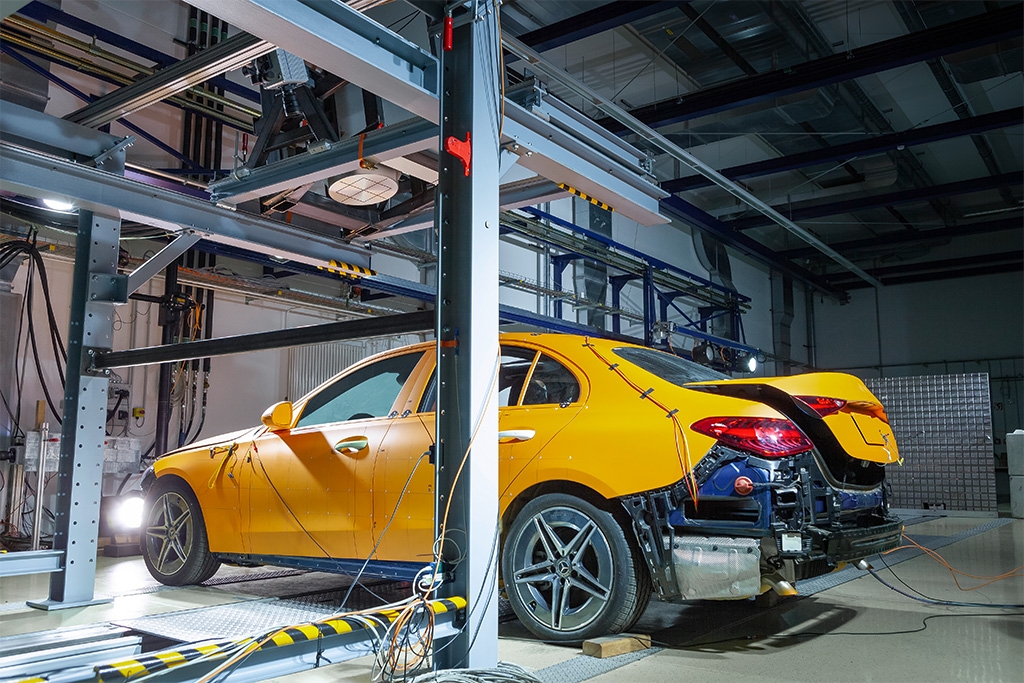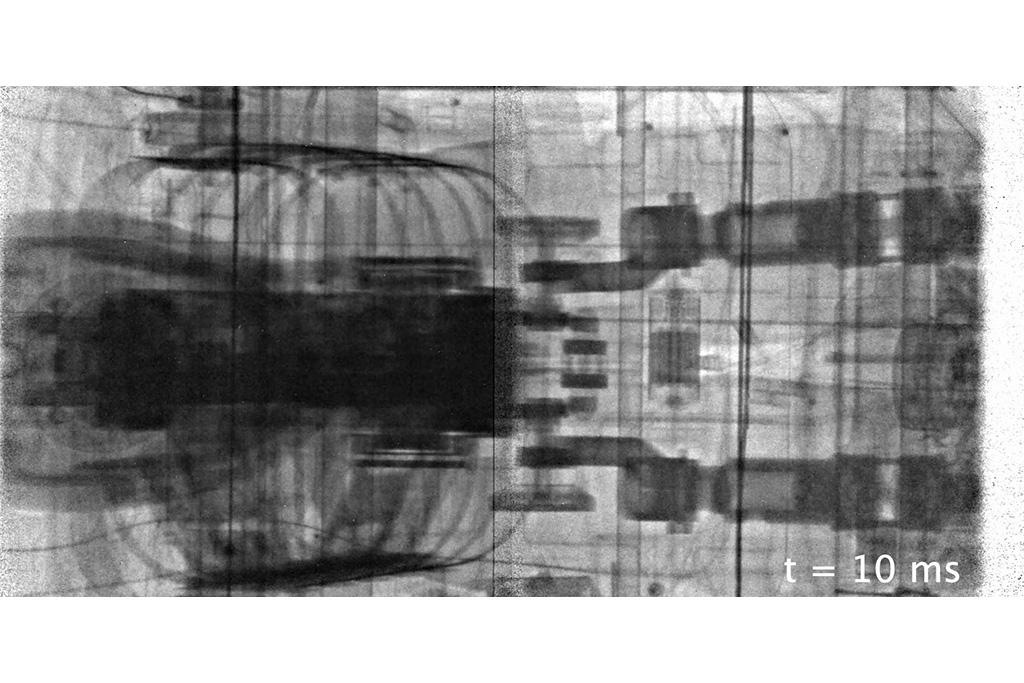Mercedes-Benz first manufacturer to use X-ray in crash test
19 Mar 2024|206 views
In collaboration with the Fraunhofer-Institute of High-Speed Dynamics and the Ernst Mach Institute (EMI), Mercedes-Benz has carried out the world's first X-ray crash test. The two parties state that the use of the technology allows for the visualisation of "highly dynamic internal deformation processes" in vehicles, following which analysis and further development could potentially improve vehicle safety.
The crash test was conducted using a C-Class Saloon, which was rammed into on its side at using a device with a crash barrier, travelling at 60km/h. What made this particular side impact test special, however, was a linear in the hall ceiling above the vehicle, which served as an X-ray camera.
Interestingly, Mercedes-Benz states that the use of X-ray technology in crash test trials isn't new. The determinant that enabled the breakthrough of this test, however, was the use of a linear accelerator with 1kHz technology as the radiation source. This device is more powerful than the X-ray flashes that were used in previous trials.
The duration of the X-ray pulse is a mere few seconds, creating the possibility to record deformation processes in the crash test without motion blur.
Beyond this, the linear accelerator generates a continuous stream of X-ray pulses. This creates the possibility of capturing 1,000 images per second - in turn, a whopping 1,000 times the number produced by conventional X-ray procedures.
Within milliseconds, the X-ray system is able to shoot about 100 still images, which are then combined into a video. This video then provides insights into what happens inside safety-relevant components, and the dummy's body during a crash.
As to how the system roughly works, Merc states that during the crash test, beams shine through the body work and any dummies, with a flat detector located under the test vehicle acting as a digital image receiver.
As radiation hits the detector, an electrical signal is generated. The intensity of this signal is dependent on how strongly the radiation was absorbed by the vehicle and dummy. This signal then influences the grey value - similar to X-ray inspections done of luggage at the airport.
Amazingly, none of the other analysis tools is affected by the X-ray crash - most notably, the interior cameras - and can continue functioning without disturbance. And of course, the largest takeaway is that the system ultimately allows for an observation of how the thorax of a dummy is pressed, or how a component is deformed, to a level of detail that past technology has been unable to capture.
Considering the power of this system, one might expect radiation levels to be off the charts - but Mercedes-Benz and its collaborators have made sure to allay any related concerns.
Specifically, a radiation protection concept was created by experts from the EMI, including dosimeters, to en sure employees are not exposed to radiation. This comes alongside an additional 40cm thick concrete wall around the building and a protection door weighing an estimated 45 tonnes.
The plant at which these tests are being held are in accordance with legal requirements, and have also gotten government endorsement.
Mercedes-Benz states that the success of the X-ray crash test now opens a new chapter of safety research for the brand. Moving forward, the use of this new technology will enhance the study of crash behaviour of both the vehicle and occupants under realistic conditions.
In collaboration with the Fraunhofer-Institute of High-Speed Dynamics and the Ernst Mach Institute (EMI), Mercedes-Benz has carried out the world's first X-ray crash test. The two parties state that the use of the technology allows for the visualisation of "highly dynamic internal deformation processes" in vehicles, following which analysis and further development could potentially improve vehicle safety.
The crash test was conducted using a C-Class Saloon, which was rammed into on its side at using a device with a crash barrier, travelling at 60km/h. What made this particular side impact test special, however, was a linear in the hall ceiling above the vehicle, which served as an X-ray camera.
Interestingly, Mercedes-Benz states that the use of X-ray technology in crash test trials isn't new. The determinant that enabled the breakthrough of this test, however, was the use of a linear accelerator with 1kHz technology as the radiation source. This device is more powerful than the X-ray flashes that were used in previous trials.
The duration of the X-ray pulse is a mere few seconds, creating the possibility to record deformation processes in the crash test without motion blur.
Beyond this, the linear accelerator generates a continuous stream of X-ray pulses. This creates the possibility of capturing 1,000 images per second - in turn, a whopping 1,000 times the number produced by conventional X-ray procedures.
Within milliseconds, the X-ray system is able to shoot about 100 still images, which are then combined into a video. This video then provides insights into what happens inside safety-relevant components, and the dummy's body during a crash.
As to how the system roughly works, Merc states that during the crash test, beams shine through the body work and any dummies, with a flat detector located under the test vehicle acting as a digital image receiver.
As radiation hits the detector, an electrical signal is generated. The intensity of this signal is dependent on how strongly the radiation was absorbed by the vehicle and dummy. This signal then influences the grey value - similar to X-ray inspections done of luggage at the airport.
Amazingly, none of the other analysis tools is affected by the X-ray crash - most notably, the interior cameras - and can continue functioning without disturbance. And of course, the largest takeaway is that the system ultimately allows for an observation of how the thorax of a dummy is pressed, or how a component is deformed, to a level of detail that past technology has been unable to capture.
Considering the power of this system, one might expect radiation levels to be off the charts - but Mercedes-Benz and its collaborators have made sure to allay any related concerns.
Specifically, a radiation protection concept was created by experts from the EMI, including dosimeters, to en sure employees are not exposed to radiation. This comes alongside an additional 40cm thick concrete wall around the building and a protection door weighing an estimated 45 tonnes.
The plant at which these tests are being held are in accordance with legal requirements, and have also gotten government endorsement.
Mercedes-Benz states that the success of the X-ray crash test now opens a new chapter of safety research for the brand. Moving forward, the use of this new technology will enhance the study of crash behaviour of both the vehicle and occupants under realistic conditions.
Latest COE Prices
August 2025 | 2nd BIDDING
NEXT TENDER: 03 Sep 2025
CAT A$104,524
CAT B$124,400
CAT C$72,190
CAT E$125,001
View Full Results Thank You For Your Subscription.


























